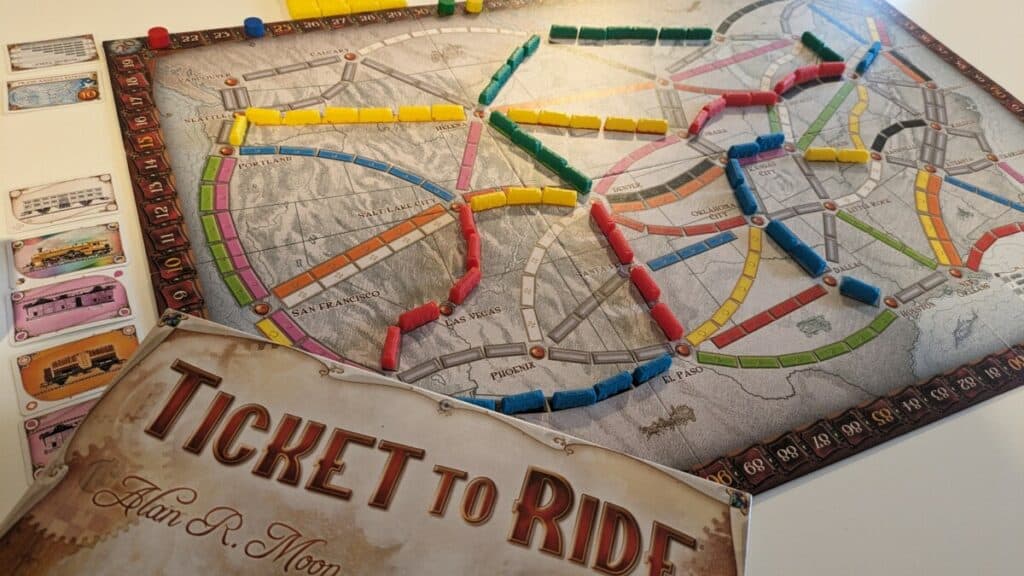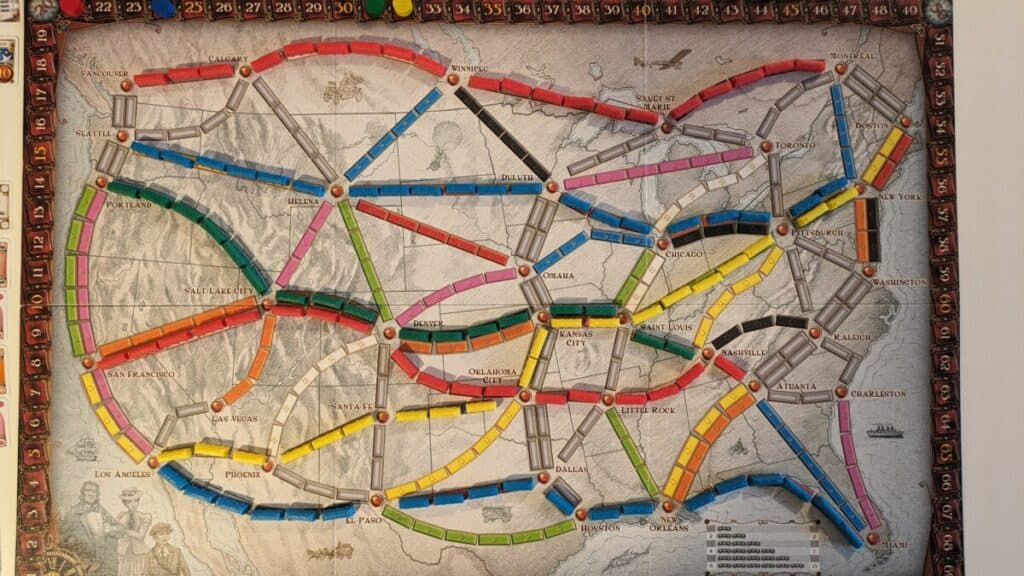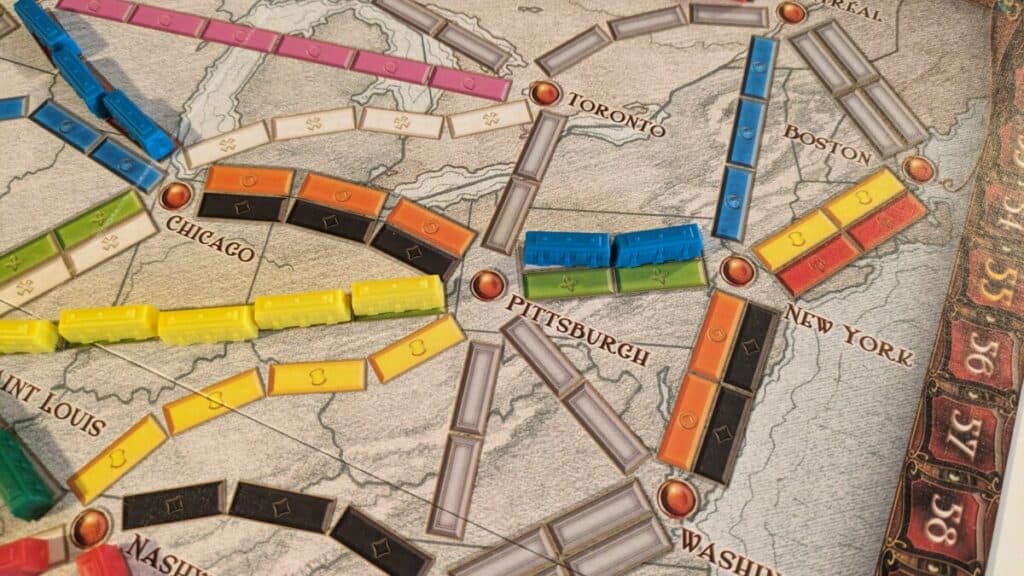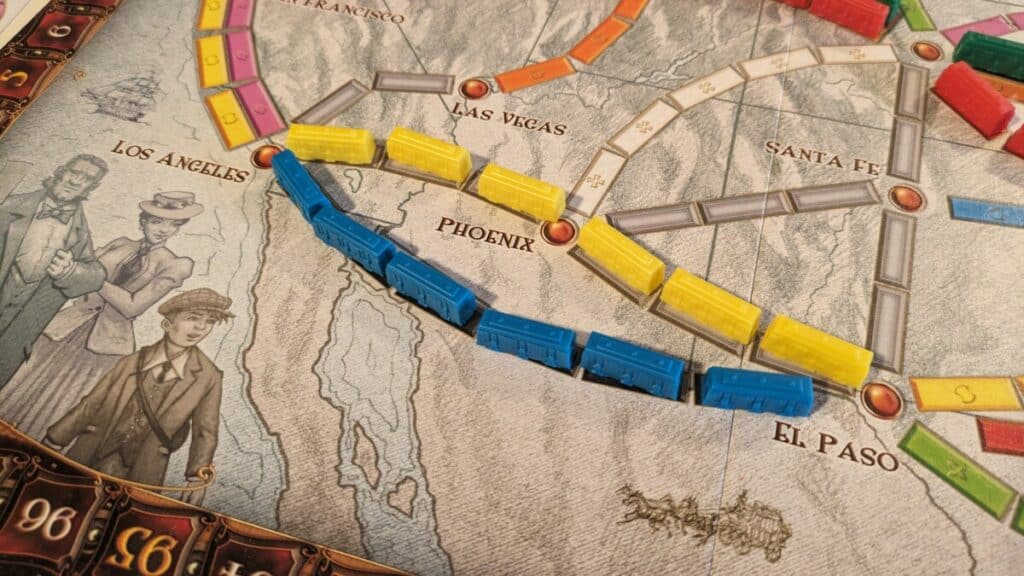
Ticket to Ride has become one of my favorite board games to play with my family. It has a fun combination of strategy and luck and is easily accessible to new players. After playing many games with friends and family I have learned which strategies work and which don’t. These tips and strategies will help you win Ticket to Ride more often and have more fun while doing it.
Generally, the best Ticket to Ride strategies are accumulating many Train cards from the draw pile, keeping long, well-coordinated Destination cards, and playing many trains on consecutive turns. You should also obstruct your opponents’ routes and try to claim important bottlenecks early on.
Every game of Ticket to Ride plays out differently, which is part of what keeps it so fun. Knowing how and why to apply each of the strategies below will help you establish a winning plan to dominate your opponents. I’ll assume you already know the rules, but if you need a refresher you can check them out here.
Build up your hand with more Train cards

Early in the game, you should focus on gathering Train cards rather than claiming short routes. There is no limit to the amount of Train cards you’re allowed to hold in your hand, so accumulating a large stockpile will serve you well for the rest of the game.
By collecting more Train cards, you’ll be able to place trains on longer routes and be more flexible with where your train placement. This strategy seems slow at the beginning but it pays off later in the game when you begin to use your Train cards to quickly complete Destination cards and easily disrupt opponents.
CHECK IT OUT: My Complete Strategy Guide to Ticket to Ride: Europe covers all of the different approaches you’ll need to take to the popular sequel.
By delaying placing any trains you also get some valuable insight into your opponents’ plans. While you stockpile cards, look at where your opponents are playing and try to get a feel for what routes they’re trying to complete. Your opponents will be completely in the dark about your Destination cards since you’ll be playing no (or very few) trains early in the game.
Keep at least one long Destination card
In general, you should always try to keep at least one long Destination card at the beginning of the game. These cards provide an enormous amount of points when completed and they can provide you with a strong base from which to build the rest of your strategy.
The longest Destination cards in the game are cross-country routes, usually oriented from East to West.
| Route | Points | Min. Distance | Points/Distance |
|---|---|---|---|
| Seattle to New York | 22 | 20 | 1.1 |
| Los Angeles to New York | 21 | 20 | 1.05 |
| Los Angeles to Miami | 20 | 19 | 1.05 |
| Vancouver to Montreal | 20 | 20 | 1 |
| Portland to Nashville | 17 | 17 | 1 |
| San Franciso to Atlanta | 17 | 17 | 1 |
| Los Angeles to Chicago | 16 | 16 | 1 |

If you don’t draw one of these Destination cards, you should probably still try to keep your longest one. This gives you some direction in your planning and will also likely serve as the basis of your ‘Longest Route’ for the end of the game.
Keep shorter Destination cards with many players
When playing with a lot of players, the board starts to fill up quickly and your options may become more limited. It could potentially become very difficult to complete an extremely long destination card, so it might be wise to discard them and instead choose to focus on medium-length routes.
I would still recommend that you keep your longest Destination card, but this really comes down to your own personal play style. If you are playing with 5 players and you have a very long route like Los Angeles to New York then it would probably be wise to claim some of the shorter routes around the two terminal ends of the route early in the game to make sure you don’t become blockaded from that city entirely.

For example, try to connect New York to Pittsburgh and/or Las Vegas to Phoenix route early in the game so that you have more paths to choose from.
Keep related Destination cards
The last, and perhaps most important strategy related to Destination cards is to keep cards that overlap or coordinate well with one another. Shorter routes that share segments with longer routes are ideal since building on those segments serves to help complete both cards.
CHECK IT OUT: Do you love Ticket to Ride but hate the big cardboard box it comes in? Check out this handy hard shell travel case on Amazon that makes transporting the game safer and more manageable.
The flip side of this coin is to discard Destination cards that don’t work well together. If you have two longer routes on the Eastern seaboard and another in the West, it’s likely best to discard the one in the West and focus all of your efforts on the two that work well together in the East.
If and when you draw more Destination cards later in the game this same principle applies. Only keep cards that meld well with your previously established routes so that you aren’t starting from scratch.
Claim important bottleneck routes early
When visualizing the routes on your Destination cards, look for pinch points or bottlenecks that would have the potential to become problematic. All cities have several ways to reach them, but some have more than others. As the game progresses, some of the routes into these cities will be claimed by other players making it more difficult for you to reach your destination.
Where these bottlenecks form is completely dependent on the Destination Cards you draw and how the game unfolds. It could be that your opponents are playing in a different part of the board and your path remains unobstructed but more likely you’ll see that routes to important cities start to get clogged. If the route you want to take is highly dependent on one or more intermediate cities, claim those routes early so that your plans aren’t irreparably damaged.
Focus on central hubs and work outward
Controlling the center of the board is a very powerful strategy in Ticket to Ride because it gives you a lot of flexibility. Most Destination cards run through the center of the board at some point, making that central real estate very valuable.
DID YOU KNOW? Ticket to Ride has a ton of offshoots with fun new maps and rules to try. You can check them all out here on Amazon.
If you’re trying to build a cross-country route, consider staking your claim in the middle of the board first. This makes it difficult for your opponent to know where you’re planning to go next and gives you plenty of options for paths to take. If an opponent claims the most direct route to one of your destination cities you can simply go a different way.
Claim longer routes for added value
A lot of players like to claim short routes as quickly as possible, banking those points and establishing their position on the board. However, unless a short route is very important to completing a Destination card, this approach is often too short-sighted. Instead of claiming multiple short routes, keep drawing cards and saving up to claim longer routes (5 or 6 train cars in length). This approach has several benefits:
- Additional point value per train car
- Fewer turns used to claim a long distance
- Makes it more difficult for opponents to anticipate your moves

In the example above, if you want to establish a connection between Los Angeles and El Paso, it is generally better to save up black Train cars and claim the 6-length route instead of playing two sets of 3 on the gray routes. This nets you 15 points instead of just 8, and your opponents don’t have a chance to block you in between claiming the two gray routes.
Draw from the face-down pile more often
In general, it is usually better to draw from the face-down pile in Ticket to Ride. This is especially true at the beginning of the game when you’re mostly looking to establish a large bank of Train tickets and the exact colors don’t particularly matter. You want a diverse hand that gives you more flexibility instead of building for one particular route.
Drawing from the face-down pile also gives you a better chance at additional Locomotives/Wild cards, while keeping your opponents in the dark about what routes you’re planning to claim.
There are, of course, exceptions. For example, if you’re approaching the end of the game and you absolutely have to complete a specific route for a Destination card then you should draw the necessary face-up cards, if available.
Claim routes in bursts to prevent interference
One of the biggest benefits of drawing a lot of Train cards early in the game is being able to claim several routes in consecutive turns. By playing your trains in rapid succession you give your opponents much less time to react, making it more difficult for them to block you.
Block opponents from completing Destinations
Speaking of blocking, you should be trying to block your opponents from completing their Destination cards. This is especially true for long Destination cards that are worth a lot of points. It’s worth memorizing the longest Destination cards in the game (see above) so that you can be on the lookout for your opponents working to complete them.
Blocking your opponent is especially effective in two-player games. Every point you deny your opponent is just as valuable as a point you score for yourself. In games with 3 or more players this return isn’t quite as good because you’re spending a turn to deny one player points while other players can focus on building their own routes.
Always be working at least one Destination card
In general, you should always have at least one Destination card that you’re working to complete. It is quite common to be about 2/3 of the way through a game and you’ve completed all of your original Destination cards. Go ahead and draw more so that you have some direction and purpose for the rest of the game.
The exception to this is if you’re getting very close to the end of the game. If you know you’ll only have 2 or 3 turns left and you’re low on Train cards it’s not worth picking up new Destination cards. You’ll likely have to spend at least one of those turns drawing more Train cards and you won’t have time to complete your new Destinations (causing you to lose points).
Control all routes from a central hub
One of my favorite strategies in Ticket to Ride is claiming all of the routes connecting to a central hub city. This forces your opponents to circumvent that city entirely, making it difficult and time-consuming to work around you.

Similarly, as shown in the photo above, you can try to claim all of the shorter routes going in a particular direction in one area of the country. For example, try claiming the 2-length routes extending East from Omaha, Kansas City, Oklahoma City, and Dallas. This effectively creates a wall that almost entirely divides the country in two, making it very difficult (or impossible) for players to pass. Things get especially clogged if you do this in a game with 4 or 5 players!
Track which cards your opponents are collecting
Winning at Ticket to Ride usually comes down to who can sabotage other players the most effectively. When your opponents draw from the face-up Train cards, remember what colors they’re drawing and look for colors of those routes that they’re likely targeting. If you have the Train cards to claim that route for yourself before their next turn, go ahead and claim it to foil their well-laid plans.
For example, the other night my wife had a nice long route running from New York to Denver. I noticed that she drew two red cards during her turn and I figured she was probably trying to connect New York to Los Angeles, so I claimed the Denver to Salt Lake City route on my next turn. She was not happy with me.
Watch how many trains your opponents have left
The end of Ticket to Ride can quickly sneak up on you if you’re not paying attention. After an opponent claims a route, always take a quick glance at how many trains they have left in their stock. This will help you manage how quickly you need to play your own trains so that you aren’t left with too many when the game ends.
You can often use this to your advantage if you’ve been stockpiling Train cards. By claiming many long routes in consecutive turns toward the end of the game you can quickly deplete your stockpile of trains and catch your opponents off guard. You can end the game before they have time to fully react, leaving them with wasted trains.
Play more trains late in the game
On that note, you should always be looking to play more trains toward the end of the game so that you aren’t left holding them. Every unplayed train you have at the end of the game is a wasted resource that could have been scoring you points, so always aim to be the player who runs out of trains first.
It’s usually not worth drawing more Train or Destination cards at the end of the game because you likely won’t have the time to make use of them. In the last couple of turns of the game, just claim as many routes as you can to maximize their value.
Create the longest route by connecting routes late
As you play your last remaining trains, don’t do it indiscriminately. Look for routes that will connect some of your shorter routes, giving you a better chance at claiming the ‘Longest Route’ card for 10 extra points. If you can’t do that, look for places where your opponents might try to do the same and claim them first. Remember that routes can circle around and pass through the same city twice.
Ignore destination tickets and claim long routes
Some Ticket to Ride players choose to ignore most of the strategies outlined above and go for a completely different playing style. This is generally reserved for more advanced and cutthroat players but can be perfectly viable.
Instead of working to complete Destination cards, you can choose to only keep one Destination card at the beginning of the game and focus entirely on claiming long routes (5 and 6 length) worth a lot of points. Routes of lengths 5 and 6 are worth 10 and 15 points, respectively, so this strategy can rack up a lot of points very quickly.
This strategy is also harder for opponents to counteract since you aren’t building towards any particular destination. The routes you claim will appear very haphazard, with no central focal point or goal. It can also frustrate opponents who need to claim one or more of those longer routes to reach their Destinations.
This approach to the game is unconventional and risky but can offer a completely new experience for advanced players looking to liven things up.
If you’ve enjoyed these strategy tips, you’ll also enjoy reading my Ultimate Strategy Guide to Ticket to Ride: Europe. If I missed anything or you’d like to add some strategy tips, please comment below!
Thanks for reading! If I missed something or you have your own opinions, please drop a comment below.
What is thr benefit of along out first in hand? Seems to me like you would never want to assume…
Your strategy comments are excellent, well thought out and very helpful! Thank you
You would only get to draw and play a Sanctuary card on turn two of round one if the Region…
Rule question. If in phase one of round one I play a Region card with a Clue symbol at the…

Leave a Reply